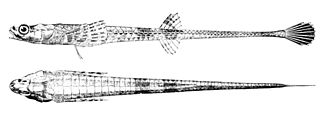
Agonidae is a family of small, bottom-dwelling, cold-water marine fish. Common names for members of this family include poachers, Irish lords, sea ravens, alligatorfishes, starsnouts, hooknoses, and rockheads. They are notable for having elongated bodies covered by scales modified into bony plates, and for using their large pectoral fins to move in short bursts. The family includes about 59 species in some 25 genera, some of which are quite widespread.

Synanceia verrucosa, the reef stonefish or just stonefish, is a species of venomous, marine ray-finned fish, a stonefish belonging to the subfamily Synanceiinae which is classified as being within the family Scorpaenidae, the scorpionfishes and their relatives. It is the most widespread species of stonefish, mostly found in shallow waters of the Red Sea and the Indo-Pacific. It is the deadliest fish in the sea, with highly effective venom which can be lethal to humans.

Venomous fish are species of fish which produce strong mixtures of toxins harmful to humans which they deliberately deliver by means of a bite, sting, or stab, resulting in an envenomation. As a contrast, poisonous fish also produce a strong toxin, but they do not bite, sting, or stab to deliver the toxin, instead being poisonous to eat because the human digestive system does not destroy the toxin they contain in their bodies. Venomous fish do not necessarily cause poisoning if they are eaten, as the digestive system often destroys the venom.

The rough frog, also known as the woodland water-holding frog, warty water-holding frog, and red-backed cyclorana, is a species of treefrog native to northern New South Wales and south-eastern Queensland, Australia.

Montipora is a genus of Scleractinian corals in the phylum Cnidaria. Members of the genus Montipora may exhibit many different growth morphologies. With eighty five known species, Montipora is the second most species rich coral genus after Acropora.

Callitris verrucosa, also known as the Mallee Pine, is a species of conifer in the family Cupressaceae. It is found only in Australia. The tree/shrub has a green/grey colour, rigid branches and can reach a height of 8m. The tree/shrub has a slow grow rate.
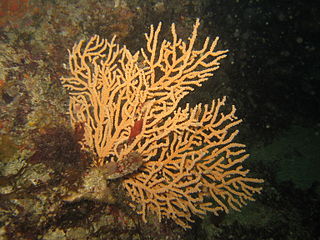
Eunicella verrucosa, the broad sea fan, pink sea fan or warty gorgonian, is a species of colonial Gorgonian "soft coral" in the family Gorgoniidae. It is native to the north-eastern Atlantic Ocean and the western Mediterranean Sea.

Synanceia is a genus of ray-finned fish belonging to the subfamily Synanceiinae, the stonefishes, which is classified within the family Scorpaenidae, the scorpionfishes and relatives. Stonefishes are venomous, dangerous, and fatal to humans. They are the most venomous fish known. They are found in the coastal regions of the Indo-Pacific.

Eriphia verrucosa, sometimes called the warty crab or yellow crab, is a species of crab found in the Black Sea, Mediterranean Sea and eastern Atlantic Ocean from Brittany to Mauritania and the Azores. Individual crabs have been caught as far north as Cornwall. Formerly a frequent species in the Black Sea, it has decreased in numbers since the 1980s and is now listed in the Ukrainian Red Data Book of endangered species.

Hymenaea verrucosa is a species of flowering plant in the legume family, Fabaceae. It belongs to the paraphyletic subfamily Caesalpinioideae. It is a large tree native to the tropical regions of East Africa and is cultivated in many tropical parts of the world. The species is currently treated as a species of Hymenaea, though a few authors isolate it into a separate monospecific genus Trachylobium as Trachylobium verrucosum.
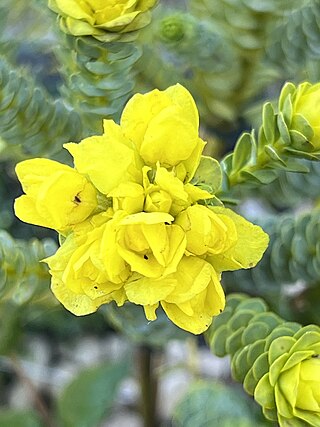
Geleznowia is a monotypic genus of a flowering plant in the family Rutaceae. It is a small shrub with oval-shaped leaves, yellow flowers and is endemic to Western Australia. Its only species is Geleznowia verrucosa.
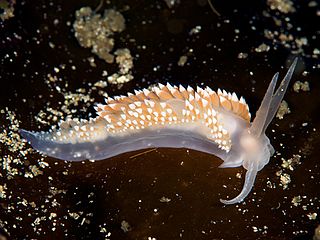
Coryphella verrucosa, is a species of sea slug, an aeolid nudibranch, a marine gastropod mollusc in the family Coryphellidae.

Ralfsia verrucosa is a species of crustose brown seaweed in the family Ralfsiaceae. It grows intertidally in temperate waters around the world. In South Africa it is part of a mutualistic relationship with a limpet.

Scorpaenopsis diabolus, the false stonefish, false scorpionfish or the devil scorpionfish, is a species of venomous marine ray-finned fish belonging to the family Scorpaenidae, the scorpionfishes. It has venomous spines and lives in the tropical Indian and Pacific Oceans as well as in the Red Sea. It is a bottom-dwelling predator that relies on its camouflage to catch passing prey.
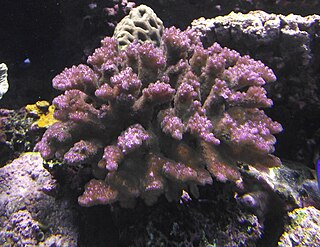
Pocillopora verrucosa, commonly known as cauliflower coral, rasp coral, or knob-horned coral, is a species of stony coral in the family Pocilloporidae. It is native to tropical and subtropical parts of the Indian and Pacific Oceans.

Crotalaria verrucosa, the blue rattlepod, is a species of flowering plant in the legume family, Fabaceae. This shrub belongs to the subfamily Faboideae. The herb found in Bangladesh, China, Cambodia, India, Indonesia, Laos, Malaysia, Myanmar, Nepal, Philippines, Sri Lanka, Thailand, Vietnam; Australasia and Africa and Americas regions.

Rafflesia verrucosa was first identified and characterized during a small mammal survey of Mt. Kampalili in eastern Mindanao in 2010. R. verrucosa is the tenth species of Rafflesia found in the Philippines. Rafflesia species have rare and unusual flowers known for their large size and pungent smell. Some plant enthusiasts like Frits W. Went have gone to extreme measures to see these plants in bloom. Went detailed his search for Rafflesia saying,
"I had heard, when I was in Java many years ago, that Rafflesia were to be found on an offshore island named Nusah Kembangan. This was in 1929, when it was a penal colony for major criminals. My driver on this occasion was a convicted murderer, and my guide was serving time for cannibalism."
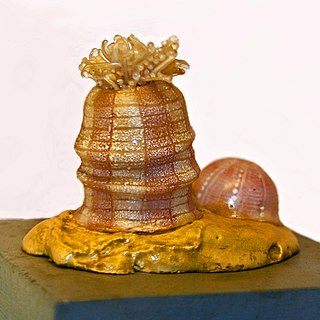
Aulactinia verrucosa, the gem anemone, is a species of sea anemone in the family Actiniidae. It is found on rocky coasts in the northeastern Atlantic Ocean, North Sea and Mediterranean Sea.

Phialophora verrucosa is a pathogenic, dematiaceous fungus that is a common cause of chromoblastomycosis. It has also been reported to cause subcutaneous phaeohyphomycosis and mycetoma in very rare cases. In the natural environment, it can be found in rotting wood, soil, wasp nests, and plant debris. P. verrucosa is sometimes referred to as Phialophora americana, a closely related environmental species which, along with P. verrucosa, is also categorized in the P. carrionii clade.
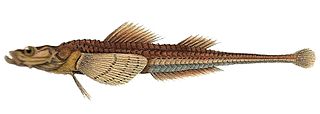
Brachyopsinae is a subfamily of marine ray-finned fishes belonging to the family Agonidae, part of the sculpin superfamily Cottoidea. These fishes are found in the North Pacific Ocean.



















